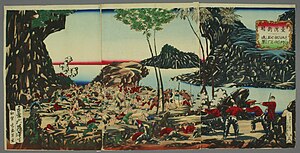Taiwan Expedition of 1874
| Taiwan Expedition of 1874 | |||||||||
|---|---|---|---|---|---|---|---|---|---|
| Part of the | |||||||||
 Commander-in-chief Saigo and his staff.  The Battle of Stonegate (石門進撃), May 22, 1874. |
|||||||||
|
|||||||||
| Belligerents | |||||||||
|
|
Paiwan |
||||||||
| Commanders and leaders | |||||||||
|
|
Tauketok † | ||||||||
| Strength | |||||||||
|
Land: 3,600 Sea: unknown |
unknown | ||||||||
| Casualties and losses | |||||||||
| 6 killed ~30 wounded |
~30 killed | ||||||||
|
|||||||||
The Japanese punitive expedition to Taiwan in 1874, referred to in Japan as the Taiwan Expedition (Japanese: 台湾出兵 Hepburn: Taiwan Shuppei?) and in Taiwan and mainland China as the Mudan incident (Chinese: 牡丹社事件), was a punitive expedition launched by the Japanese in retaliation for the murder of 54 Ryukyuan sailors by Paiwan aborigines near the southwestern tip of Taiwan in December 1871. The success of the expedition, which marked the first overseas deployment of the Imperial Japanese Army and Imperial Japanese Navy, revealed the fragility of the Qing dynasty's hold on Taiwan and encouraged further Japanese adventurism. Diplomatically, Japan's embroilment with China in 1874 was eventually resolved by a British arbitration under which Qing China agreed to compensate Japan for property damage. Some ambiguous wording in the agreed terms were later argued by Japan to be confirmation of Chinese renunciation of suzerainty over the Ryukyu Islands, paving the way for de facto Japanese incorporation of Ryukyu in 1879.
In December 1871 a Ryukyuan vessel was shipwrecked near the southern tip of Taiwan. Fifty-four members of its crew of 66 were beheaded by the Paiwan aborigines. The remaining 12 crewmen were rescued by Han Chinese and were transferred to Tainan in southern Taiwan. The local Qing Chinese government officials transferred them to Fujian province in mainland China. From there, the Qing government arranged to send them back home.
...
Wikipedia
